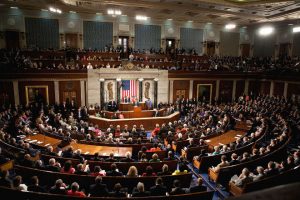 Curious fact, and one disquieting for Republicans looking ahead to 2018: In the past 65 years, starting with 1952, the president’s party has managed to win a majority of seats in an off-year election only four times. In the other 12 off-year elections, the opposition party won a majority.
Curious fact, and one disquieting for Republicans looking ahead to 2018: In the past 65 years, starting with 1952, the president’s party has managed to win a majority of seats in an off-year election only four times. In the other 12 off-year elections, the opposition party won a majority.
Special circumstances, unlikely to be replicated next year, accounted for the four presidential party victories.
In two of these off-year elections, 1966 and 1978, a Democratic president’s party had won better than 2-1 majorities in the House two years before. In the 1966 backlash against Lyndon Johnson’s Great Society, Democrats were reduced from 295 seats to 247, but it was still well above the 218 needed for a majority. In a milder recoil against Jimmy Carter in 1978, Democrats were reduced from 292 seats to a still robust 277.
Those precedents don’t apply now. Yes, Republicans won 241 House seats in November 2016 and have held on to the four up for grabs in the special elections this spring, and they’re unlikely to lose the one currently vacant seat, in Utah, in the special election next fall. But unlike the Democrats in 1966 and 1978, who could have lost 70-plus seats and still kept a majority, Republicans will lose theirs next year if they lose a net of only 24 seats.
In the other two off-years in which incumbent parties held House majorities, the president enjoyed highly positive job approval. John F. Kennedy’s approval rating in October and November 1962 ranged from 62 to 74 percent. George W. Bush’s approval numbers ranged from 56 to 59 percent in those months in 2002.
Those approval ratings were boosted by their responses to foreign threats — Soviet threats on Berlin and the Cuban missile crisis in 1961-62, the 9/11 attacks and fighting in Afghanistan in 2001-02. It’s possible that his response to similar crises could boost Donald Trump’s job approval far above his current 40 percent.
But these precedents are not necessarily applicable, either. Democrats had what everyone considered a permanent House majority for going on four decades. In every congressional election from 1958 to 1992, they won at least 243 seats — more than Republicans won in every election over the past 65 years except 2014.
During that period, most voters usually split their tickets, favoring Republicans for president and Democrats for Congress. In that climate, major legislation was typically bipartisan — 1970s and ’80s deregulation, the 1981 tax cuts, tax reform in 1986, the 1986 immigration law, the Clinton-Gingrich welfare reform and balanced budget in the ’90s. A key role was often played by the traditionally bipartisan and ably led Senate Finance Committee.
That has changed, thanks to the polarized partisan patterns that have prevailed (except for a 2006-08 lurch toward the Democrats) since the mid-1990s. They have resulted in more narrowly divided houses of Congress, with both parties fearful (or hopeful) that the next election could change party majorities.
George W. Bush succeeded in producing bipartisan majorities for 2001 and 2003 tax cuts and the 2003 Medicare prescription drug law but failed on Social Security reform in 2005. Barack Obama proved unable to resist the temptation, given the Democrats’ luck in securing a Senate supermajority, to produce monopartisanly a stimulus package in 2009 and Obamacare in 2010.
After Republicans gained 63 seats and recaptured the House in 2010, the Democrats’ Senate leader, Harry Reid, changed Senate rules and clamped down on colleagues inclined to bipartisanship, such as Kent Conrad and Ron Wyden. The Senate Finance Committee was changed from a crucible of bipartisanship to a creature of the party leadership.
Bipartisanship means shapers of legislation have many options, whereas monopartisanship requires corralling all or all but a couple of a party’s legislators. A predictable result is flawed, slapdash mishmashes, such as Obamacare and the Republicans’ attempts at an Obamacare replacement.
Obama’s monopartisan legislation triggered a return to the 1994-2004 polarized partisan patterns. Will the Trump Republicans’ monopartisanship provoke a lurch toward the Democrats like that in 2006-08?
The special election results suggest it may. But in special elections, voters can cast protest votes without risking a change in party control. That risk is higher in off-year elections.
Analysis by Echelon Insights’ Patrick Ruffini shows that Democratic turnout spiked in the first three special elections this year. But Republican turnout spiked as well in the runoff election in Georgia’s 6th Congressional District and prevented a Democratic victory. Does that suggest the president’s party will be the fifth in 66 years to hold its House majority in the off-year elections? Maybe.
COPYRIGHT 2017 CREATORS.COM
 Michael Barone, senior political analyst at the Washington Examiner, (www.washingtonexaminer.com), where this article first appeared, is a resident fellow at the American Enterprise Institute, a Fox News Channel contributor and a co-author of “The Almanac of American Politics.”
Michael Barone, senior political analyst at the Washington Examiner, (www.washingtonexaminer.com), where this article first appeared, is a resident fellow at the American Enterprise Institute, a Fox News Channel contributor and a co-author of “The Almanac of American Politics.”
The views expressed in opinion articles are solely those of the author and are not necessarily either shared or endorsed by Black Community News.
 CURE News and Clergy Blog News and Commentary for Christians
CURE News and Clergy Blog News and Commentary for Christians



